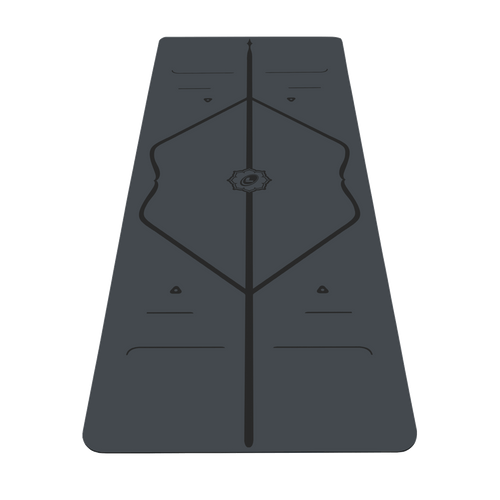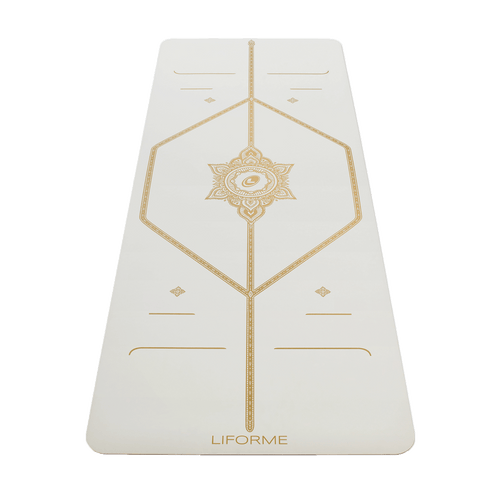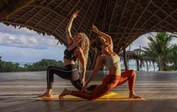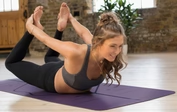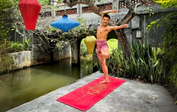In the simplest terms, modern Hatha is the physical practice of yoga poses, but its journey from the medieval Indian subcontinent to the studio down the street is a bit more complicated.
While yoga’s roots are very old, we can’t trace an unbroken line of tradition from then to now. Instead, the line is choppy, stopping and restarting somewhere else, changing in response to new contexts and new input.
Rather than delegitimizing yoga in any way, this ability to perpetually transform promises that it will endure.
The Origins of Hatha Yoga
While there are aspects of medieval Hatha Yoga that modern yogis can certainly recognize, according to historian Mark Singleton’s book Yoga Body, early Hatha Yoga (13th to 18th centuries) was focused on fortifying the body against decay.
It included purification rituals, some of which, like neti pot cleansing and Khapalabhati breathing, we still see today. Others, such as dhauti (swallowing a strip of cloth to clean the digestive system) and basti (a type of enema), have become more obscure.
Early sources such as the Hatha Yoga Pradipika and Goraksha Sataka mention the value of pranayama and asana in the pursuit of immortality but describe only a few postures.
Between the 18th and 20th centuries, Hatha Yoga fell out of favour. Hatha yogis were viewed as madmen, mendicants, and magicians, and they were often itinerant ascetics who conducted their rituals as street performances.
Prominent figures in yoga’s international dissemination at the turn of the 20th century, such as Swami Vivekananda, downplayed the role of physical Hatha practices in favour of Raja Yoga, which he characterized as a higher form of yoga concerned with the mind and spirit instead of the body.
It wasn’t until the 1930s that Hatha began to reenter the yoga conversation as the global enthusiasm for fitness, bodybuilding, and gymnastics found a receptive home in India.
The revival of Hatha coincided with the international physical culture movement, during which time T. Krishnamacharya, often called the Father of Modern Yoga, began teaching a calisthenics-influenced form of asana in Mysore, India.
His students included B.K.S. Iyengar and Ashtanga Yoga founder K. Pattabhi Jois, both of whom were later instrumental in the spread of yoga asana and its current popularity. Their efforts and teachings created the modern understanding of Hatha as the practice of yoga postures.
The Meaning of Hatha
There are two interpretations of the Sanskrit meaning of Hatha. The first is a direct translation of the word, which means forceful or strong.
Although Hatha Yoga is considered gentle by modern standards, its physicality, which has always included breathwork and postures, may have qualified it as a strong practice by contemporary measures or in comparison to more meditative practices. Hatha may also have referred to the forceful effects felt in the body.
The second interpretation, which is called the esoteric definition, relies on breaking the word into two syllables: ha, meaning sun, and tha meaning moon.
In his paper, “The Meaning of hatha in Early Hathayoga,” an excellent source for further study of this subject, Jason Birch explains that this translation is first seen in surviving texts in the 13th-century Yogabija.
Both historical definitions can deepen our modern understanding of Hatha Yoga. Hatha is a physical practice of movement and breath. It is concerned with the union of opposites, helping us to integrate the extremes of human experience (good/bad, day/night, sun/moon) into a whole, healthy person.
What Is Modern Hatha Yoga?
When you walk into your neighbourhood yoga studio to take a Hatha Yoga class, what should you expect? These days, Hatha is a very big umbrella that can encompass any physical style of yoga.
However, a Hatha class is usually a gentle exploration of basic yoga postures with minimal flow between poses. Some studios will also offer Hatha Flow, Hatha Vinyasa, or Advanced Hatha, which will probably include greater movement and intensity, but there aren’t universally accepted definitions for these terms. It’s perfectly reasonable to ask any teacher or studio what they mean when they use them.
The Benefits of Hatha Yoga
Modern Hatha Yoga has many mental and physical benefits.
The physical benefits include:
- Improved flexibility, especially of the hamstrings, hips, and shoulders.
- Improved muscle strength and tone.
- Better posture and body awareness.
The mental benefits include:
- Reduction of stress and anxiety.
- Improved sense of well-being.
- Better sleep and ability to relax.
How Hatha Differs from Other Yoga Styles
Hatha is a foundational style of yoga that complements and enriches other types of yoga. It’s great for beginners and a wonderful practice to return to again and again.
Unlike Vinyasa, the emphasis in Hatha is on individual postures rather than flow, which makes Hatha a good place to work on alignment and observe how your body reacts to longer hold times.
Unlike Ashtanga, the order of postures is entirely up to the teacher. They may use this opportunity to focus on just a few poses or types of poses.
Unlike Bikram, Hatha is not usually done in a heated environment.
Essential Hatha Yoga Pose for Beginners

Mountain Pose (Tadasana)
Sanskrit Meaning: Tada (Mountain)
Yoga Level: Beginner
Pose Type: Standing
Benefits: Improves your posture and awareness of alignment.
Step-by-Step:
1. Come to stand at the front of your mat with your feet parallel.
2. Starting at your feet, bring your attention to each part of your body moving up to the crown of your head.
3. Try to stack your joints as you go: ankles, knees, hips, shoulders, crown.

Downward Facing Dog Pose (Adho Mukha Svanasana)
Sanskrit Meaning: Adho (Down) Mukha (Face) Svana (Dog)
Yoga Level: Beginner
Pose Type: Standing
Benefits: Stretches the backs of your legs and back, strengthens your arms and shoulders.
Step-by-Step:
1. Come to all fours on your hands and knees.
2. On an exhalation of breath, curl your toes under and push into your hands to lift your butt toward the ceiling and straighten your arms and legs.
3. Your body is in an inverted V shape.

Child’s Pose (Balasana)
Sanskrit Meaning: Bala (Child)
Yoga Level: Beginner
Pose Type: Prone
Benefits: Opens your hips. Provides the opportunity for rest.
Step-by-Step:
1. From a hands-and-knees position, open your knees towards the sides of your mat and bring your feet together to touch along the Central Line.
2. Sink your butt back to rest on your heels.
3. Lower your forehead to your mat.
4. Keep your arms outstretched or bring them alongside your body.

Warrior II (Virabhadrasana II)
Sanskrit Meaning: Virabhadra (a Hindu warrior)
Yoga Level: Beginner
Pose Type: Standing
Benefits: Strengthens your arms, shoulders, legs, and core.
Step-by-Step:
1. Stand facing the long side of your mat with your legs wide apart and the Central Line intersecting the arches of both feet.
2. Turn your front foot so that your toes face the front of your mat.
3. Bend your front knee over your front ankle.
4. Lift your arms parallel to the floor at shoulder height.
5. Turn your face to the front of the room.
6. Repeat the posture on your other side.

Triangle Pose (Trikonasana)
Sanskrit Meaning: Trikona (Triangle)
Yoga Level: Beginner
Pose Type: Standing
Benefits: Stretches your hamstrings and opens your chest.
Step-by-Step:
1. From Warrior II, straighten your front leg.
2. Keeping your arms outstretched, reach your front hand forward and then down to your front shin.
3. Turn your chest and your gaze toward the ceiling.
4. Repeat on the other side.

Cobra (Bhujangasana)
Sanskrit Meaning: Bhuja (Cobra)
Yoga Level: Beginner
Pose Type: Prone
Benefits: Strengthens your back and core.
Step-by-Step:
1. Lie on your stomach with your elbows bent and your palms under your shoulders.
2. On an inhalation of breath, press into your pelvis and the tops of your feet to lift your chest away from the floor any amount.
3. Release on your exhale. Repeat several times.

Seated Forward Bend: Paschimottanasana
Sanskrit Meaning: Paschima (the West, in this case, the back side of the body) Uttana (Stretch)
Yoga Level: Beginner
Pose Type: Seated
Benefits: Stretches your hamstrings and back.
Step-by-Step:
1. Sit with your legs outstretched in front of you with your feet flexed. If it’s hard to keep your spine long in the position, take a folded blanket under your seat.
2. On an exhalation, tip your pelvis forward to rotate your torso into a forward bend over your legs.
3. Keep your spine straight until you have come to your full forward rotation. Then you can choose to round your spine or keep it long.

Corpse Pose (Savasana)
Sanskrit Meaning: Sava (Corpse)
Yoga Level: Beginner
Pose Type: Supine
Benefits: Total relaxation allows your body to absorb the effects of your practice.
Step-by-Step:
1. Lie on your back with your legs separated and your palms turned toward the ceiling.
2. Close your eyes and let your feet fall out to either side as you relax from foot to crown.
Hatha for Life
A lot of people do Hatha Yoga without even realizing it because modern Hatha has come to mean any physical yoga practice. Hatha’s path from esoteric rituals to worldwide popularity has been characterized by its adaptability in serving its practitioners in each of its eras.
Undoubtedly, its evolution is far from over as new yoga methods are still emerging constantly. Finding ourselves in this continuum connects us to the yogis of the past and those of the future, strengthening the sense of common humanity that yoga fosters.








